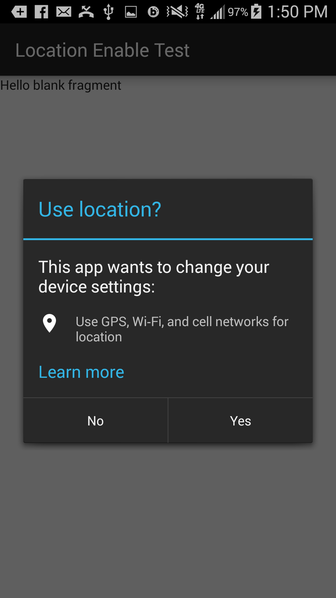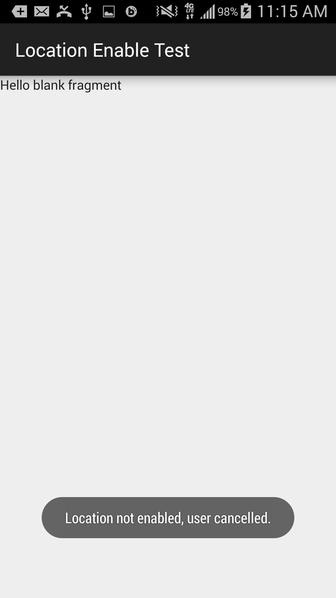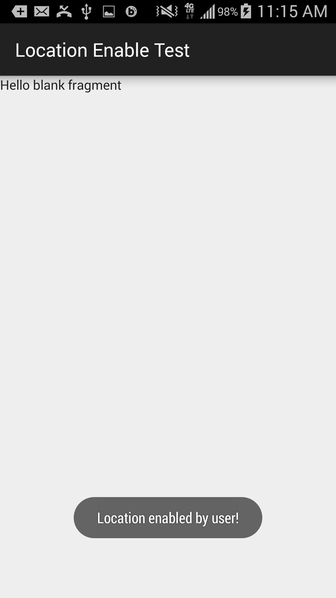La boîte de dialogue LocationSettingsRequest pour activer GPS-onActivityResult () a sauté
une partie de mon application nécessite des services de localisation, donc si la localisation est actuellement désactivée, l'application demandera à l'utilisateur de l'activer. Ici est de savoir comment je le fais: (vu Aussi dans ce Stack Overflow réponse)
LocationSettingsRequest.Builder builder = new LocationSettingsRequest.Builder()
.addLocationRequest(mLocationRequest);
builder.setAlwaysShow(true);
PendingResult<LocationSettingsResult> result = LocationServices.SettingsApi.checkLocationSettings(mGoogleApiClient, builder.build());
result.setResultCallback(new ResultCallback<LocationSettingsResult>()
{
@Override
public void onResult(LocationSettingsResult result)
{
final Status status = result.getStatus();
final LocationSettingsStates = result.getLocationSettingsStates();
switch (status.getStatusCode())
{
case LocationSettingsStatusCodes.SUCCESS:
// All location settings are satisfied. The client can initialize location
// requests here.
...
Log.d("onResult", "SUCCESS");
break;
case LocationSettingsStatusCodes.RESOLUTION_REQUIRED:
// Location settings are not satisfied. But could be fixed by showing the user
// a dialog.
Log.d("onResult", "RESOLUTION_REQUIRED");
try
{
// Show the dialog by calling startResolutionForResult(),
// and check the result in onActivityResult().
status.startResolutionForResult(OuterClass.this, REQUEST_LOCATION);
}
catch (SendIntentException e)
{
// Ignore the error.
}
break;
case LocationSettingsStatusCodes.SETTINGS_CHANGE_UNAVAILABLE:
// Location settings are not satisfied. However, we have no way to fix the
// settings so we won't show the dialog.
...
Log.d("onResult", "UNAVAILABLE");
break;
}
}
});
@Override
public void onActivityResult(int requestCode, int resultCode, Intent data)
{
// This log is never called
Log.d("onActivityResult()", Integer.toString(resultCode));
final LocationSettingsStates states = LocationSettingsStates.fromIntent(data);
switch (requestCode)
{
case REQUEST_LOCATION:
switch (resultCode)
{
case Activity.RESULT_OK:
{
// All required changes were successfully made
break;
}
case Activity.RESULT_CANCELED:
{
// The user was asked to change settings, but chose not to
break;
}
default:
{
break;
}
}
break;
}
}
Ce code fonctionne bien, cependant, onActivityResult() est toujours ignorée. Que l'utilisateur appuie ou non sur Yes , No ou back à partir de Dialog , onActivityResult() ne fonctionne pas.
J'ai besoin D'Android pour appeler onActivityResult() donc si l'utilisateur choisit de ne pas activer les services de localisation, je peux le gérer de manière appropriée.
la page des développeurs de Google (et le code ci-dessus) dit explicitement que onActivityResult() doit être appelé. Quelqu'un sait pourquoi il a été sauté?
Je ne sais pas non plus Quel est le but de cette ligne:
final LocationSettingsStates states = LocationSettingsStates.fromIntent(data);
Merci!
Edit: informations de base sur la structure de mon application:
- ce code est contenu dans la
onResume()méthode d'unFragmentqui met en œuvreGoogleApiClient.ConnectionCallbacks,GoogleApiClient.OnConnectionFailedListener, etLocationListenerpour recevoir des mises à jour d'emplacement. Exemple vu ici . - Dans
onLocationChanged()leFragmentaura une coutumeViewappelinvalidate()et se dessiner à nouveau avec des informations mises à jour.
7 réponses
il semble que le problème principal est que vous avez tout le code dans un Fragment, et depuis startResolutionForResult() a besoin d'une activité passée en elle, L'activité est ce qui obtient le rappel onActivityResult() .
une façon de se déplacer qui est d'utiliser la technique décrite ici , appeler manuellement la méthode du Fragment onActivityResult() de l'activité quand le résultat vient en.
je viens d'avoir cet exemple simple qui fonctionne.
tout D'abord, L'activité, qui ajoute le Fragment, et a également la fonctionnalité de transmettre le long du résultat de onActivityResult() au Fragment:
public class MainActivity extends AppCompatActivity{
LocationFragment lFrag;
@Override
protected void onCreate(Bundle savedInstanceState) {
super.onCreate(savedInstanceState);
setContentView(R.layout.activity_main);
lFrag = LocationFragment.newInstance();
getSupportFragmentManager().beginTransaction().add(R.id.fragment_container, lFrag).commit();
}
@Override
public void onActivityResult(int requestCode, int resultCode, Intent data) {
if (requestCode == LocationFragment.REQUEST_LOCATION){
lFrag.onActivityResult(requestCode, resultCode, data);
}
else {
super.onActivityResult(requestCode, resultCode, data);
}
}
}
voici le Fragment, qui contient toutes les fonctionnalités pour afficher la boîte de dialogue, et gérer le résultat. Dans cet exemple simple j'ai juste utilisé des messages Toast pour vérifier qu'il fonctionne comme prévu. Notez que le principal changement que j'ai fait ici le code de votre question, c'est l'utilisation de getActivity() pour obtenir la référence D'activité nécessaire pour l'appel à startResolutionForResult() .
public class LocationFragment extends Fragment
implements GoogleApiClient.ConnectionCallbacks,
GoogleApiClient.OnConnectionFailedListener {
LocationRequest mLocationRequest;
GoogleApiClient mGoogleApiClient;
PendingResult<LocationSettingsResult> result;
final static int REQUEST_LOCATION = 199;
public static LocationFragment newInstance() {
LocationFragment fragment = new LocationFragment();
return fragment;
}
public LocationFragment() {
// Required empty public constructor
}
@Override
public void onCreate(Bundle savedInstanceState) {
super.onCreate(savedInstanceState);
}
@Override
public View onCreateView(LayoutInflater inflater, ViewGroup container,
Bundle savedInstanceState) {
mGoogleApiClient = new GoogleApiClient.Builder(getActivity())
.addApi(LocationServices.API)
.addConnectionCallbacks(this)
.addOnConnectionFailedListener(this).build();
mGoogleApiClient.connect();
// Inflate the layout for this fragment
return inflater.inflate(R.layout.fragment_location, container, false);
}
@Override
public void onResume() {
super.onResume();
}
@Override
public void onConnected(Bundle bundle) {
mLocationRequest = LocationRequest.create();
mLocationRequest.setPriority(LocationRequest.PRIORITY_HIGH_ACCURACY);
mLocationRequest.setInterval(30 * 1000);
mLocationRequest.setFastestInterval(5 * 1000);
LocationSettingsRequest.Builder builder = new LocationSettingsRequest.Builder()
.addLocationRequest(mLocationRequest);
builder.setAlwaysShow(true);
result = LocationServices.SettingsApi.checkLocationSettings(mGoogleApiClient, builder.build());
result.setResultCallback(new ResultCallback<LocationSettingsResult>() {
@Override
public void onResult(LocationSettingsResult result) {
final Status status = result.getStatus();
//final LocationSettingsStates state = result.getLocationSettingsStates();
switch (status.getStatusCode()) {
case LocationSettingsStatusCodes.SUCCESS:
// All location settings are satisfied. The client can initialize location
// requests here.
//...
break;
case LocationSettingsStatusCodes.RESOLUTION_REQUIRED:
// Location settings are not satisfied. But could be fixed by showing the user
// a dialog.
try {
// Show the dialog by calling startResolutionForResult(),
// and check the result in onActivityResult().
status.startResolutionForResult(
getActivity(),
REQUEST_LOCATION);
} catch (IntentSender.SendIntentException e) {
// Ignore the error.
}
break;
case LocationSettingsStatusCodes.SETTINGS_CHANGE_UNAVAILABLE:
// Location settings are not satisfied. However, we have no way to fix the
// settings so we won't show the dialog.
//...
break;
}
}
});
}
@Override
public void onActivityResult(int requestCode, int resultCode, Intent data)
{
Log.d("onActivityResult()", Integer.toString(resultCode));
//final LocationSettingsStates states = LocationSettingsStates.fromIntent(data);
switch (requestCode)
{
case REQUEST_LOCATION:
switch (resultCode)
{
case Activity.RESULT_OK:
{
// All required changes were successfully made
Toast.makeText(getActivity(), "Location enabled by user!", Toast.LENGTH_LONG).show();
break;
}
case Activity.RESULT_CANCELED:
{
// The user was asked to change settings, but chose not to
Toast.makeText(getActivity(), "Location not enabled, user cancelled.", Toast.LENGTH_LONG).show();
break;
}
default:
{
break;
}
}
break;
}
}
@Override
public void onConnectionSuspended(int i) {
}
@Override
public void onConnectionFailed(ConnectionResult connectionResult) {
}
}
Voici les résultats visuellement, d'abord la boîte de dialogue s'affiche si le Mode Location est désactivé:
ensuite, si L'utilisateur clique non, le résultat est passé de l'activité au Fragment, qui montre un Toast:
même chose lorsque l'utilisateur clique Oui, mais avec un résultat positif, et le Mode de localisation est activé:
notez que c'est peut-être une meilleure option pour garder toutes ces fonctionnalités dans L'activité, puis appeler une méthode publique dans le Fragment lorsque le résultat arrive.
voici le code complet pour conserver la fonctionnalité dans l'activité.
Bien sûr, dans cette solution, vous devrez ajouter un appel dans le Fragment pour mettre à jour l'état du Mode de localisation après onActivityResult() est appelé.
public class MainActivity extends AppCompatActivity
implements GoogleApiClient.ConnectionCallbacks,
GoogleApiClient.OnConnectionFailedListener {
LocationRequest mLocationRequest;
GoogleApiClient mGoogleApiClient;
PendingResult<LocationSettingsResult> result;
final static int REQUEST_LOCATION = 199;
@Override
protected void onCreate(Bundle savedInstanceState) {
super.onCreate(savedInstanceState);
setContentView(R.layout.activity_main);
mGoogleApiClient = new GoogleApiClient.Builder(this)
.addApi(LocationServices.API)
.addConnectionCallbacks(this)
.addOnConnectionFailedListener(this).build();
mGoogleApiClient.connect();
}
@Override
public void onConnected(Bundle bundle) {
mLocationRequest = LocationRequest.create();
mLocationRequest.setPriority(LocationRequest.PRIORITY_HIGH_ACCURACY);
mLocationRequest.setInterval(30 * 1000);
mLocationRequest.setFastestInterval(5 * 1000);
LocationSettingsRequest.Builder builder = new LocationSettingsRequest.Builder()
.addLocationRequest(mLocationRequest);
builder.setAlwaysShow(true);
result = LocationServices.SettingsApi.checkLocationSettings(mGoogleApiClient, builder.build());
result.setResultCallback(new ResultCallback<LocationSettingsResult>() {
@Override
public void onResult(LocationSettingsResult result) {
final Status status = result.getStatus();
//final LocationSettingsStates state = result.getLocationSettingsStates();
switch (status.getStatusCode()) {
case LocationSettingsStatusCodes.SUCCESS:
// All location settings are satisfied. The client can initialize location
// requests here.
//...
break;
case LocationSettingsStatusCodes.RESOLUTION_REQUIRED:
// Location settings are not satisfied. But could be fixed by showing the user
// a dialog.
try {
// Show the dialog by calling startResolutionForResult(),
// and check the result in onActivityResult().
status.startResolutionForResult(
MainActivity.this,
REQUEST_LOCATION);
} catch (SendIntentException e) {
// Ignore the error.
}
break;
case LocationSettingsStatusCodes.SETTINGS_CHANGE_UNAVAILABLE:
// Location settings are not satisfied. However, we have no way to fix the
// settings so we won't show the dialog.
//...
break;
}
}
});
}
@Override
public void onActivityResult(int requestCode, int resultCode, Intent data)
{
Log.d("onActivityResult()", Integer.toString(resultCode));
//final LocationSettingsStates states = LocationSettingsStates.fromIntent(data);
switch (requestCode)
{
case REQUEST_LOCATION:
switch (resultCode)
{
case Activity.RESULT_OK:
{
// All required changes were successfully made
Toast.makeText(MainActivity.this, "Location enabled by user!", Toast.LENGTH_LONG).show();
break;
}
case Activity.RESULT_CANCELED:
{
// The user was asked to change settings, but chose not to
Toast.makeText(MainActivity.this, "Location not enabled, user cancelled.", Toast.LENGTH_LONG).show();
break;
}
default:
{
break;
}
}
break;
}
}
@Override
public void onConnectionSuspended(int i) {
}
@Override
public void onConnectionFailed(ConnectionResult connectionResult) {
}
}
vous devez ajouter ceci à votre résultat de rappel:
case LocationSettingsStatusCodes.RESOLUTION_REQUIRED:
try {
fragment.startIntentSenderForResult(status.getResolution().getIntentSender(), REQUEST_CHECK_SETTINGS, null, 0, 0, 0, null);
} catch (IntentSender.SendIntentException e) {
// Ignore the error.
}
break;
onActivityResult sera appelée sur votre fragment, vous n'avez pas besoin de l'appeler manuellement dans votre activité. C'est essentiellement ainsi que startResolutionForResult fonctionne.
je vois que vous utilisez des constantes différentes REQUEST_CHECK_SETTINGS et REQUEST_LOCATION pour le code de requête. Ont-elles la même valeur?
pour le code: final LocationSettingsStates states = LocationSettingsStates.fromIntent(intent); .
Le but du code ci-dessus est d'obtenir l'état actuel des paramètres de localisation(comme utiliser le réseau, GPS, ...) après avoir changé le réglage.
Aussi, dans votre code, je pense que ça devrait être LocationSettingsStates.fromIntent(data); parce que le intent n'existe pas ici, peut-être que c'est juste une faute de frappe.
Its à cause de tous les codes api google présents dans les Fragments.. Essayez ce qui suit, il aidera à surmonter...
1.Créer un constructeur vide pour vos fragments.
2.besoin oncreate() la méthode avant de la onCreateView()...
3.coller le code de L'api Google dans oncreate ()....
public mainFragment(){
}
@Override
public void onCreate(Bundle savedInstanceState) {
super.onCreate(savedInstanceState);
try {
buildGoogleApiClient();
buildLocationSettingsRequest();
checkLocationSettings();
mGoogleApiClient.connect();
} catch (Exception e) {
e.printStackTrace();
}
}
pour votre référence...
Enregistrer le champ fragment en activité (comme Daniel l'a suggéré) n'est pas souvent une bonne décision, car imaginez que vous avez plusieurs fragments et que chacun contient un code de localisation. Je l'ai fait d'une manière différente:
public class MainActivity extends Activity implements PlaceFragment.SettingsModifyHandler {
private static final int LOCATION_SETTINGS_RESULT = 1;
private OnResultCallback placeCallback;
...
@Override
protected void onActivityResult(int requestCode, int resultCode, Intent data) {
super.onActivityResult(requestCode, resultCode, data);
if (requestCode == LOCATION_SETTINGS_RESULT) {
if (resultCode == Activity.RESULT_OK) {
placeCallback.resultOk();
} else {
placeCallback.resultFail();
}
placeCallback = null;
}
}
@Override
public void handle(IntentSender intentSender, OnResultCallback callback) {
placeCallback = callback;
try {
startIntentSenderForResult(intentSender, LOCATION_SETTINGS_RESULT, null, 0, 0, 0);
} catch (IntentSender.SendIntentException e) {
callback.resultFail();
}
}
}
public class PlaceFragment extends Fragment {
private SettingsModifyHandler settingsModifyHandler;
...
@Override
public void onAttach(Activity activity) {
super.onAttach(activity);
if (context instanceof SettingsModifyHandler) {
settingsModifyHandler = (SettingsModifyHandler) context;
} else {
throw new RuntimeException("Parent activity must implement PlaceFragment.SettingsModifyHandler interface");
}
}
/* Callback from module, where you implemented status.getStatusCode().LocationSettingsStatusCodes.RESOLUTION_REQUIRED case
(status is instance of com.google.android.gms.common.api.Status)
You provide intentSender here through status.getResolution().getIntentSender() */
@Override
public void placeLoadError(IntentSender sender) {
TextView view_text = (TextView) root.findViewById(R.id.text_error);
TextView view_btn = (TextView) root.findViewById(R.id.btn_reply);
view_text.setText("Need to change location settings");
view_btn.setText("Change");
view_btn.setOnClickListener(v -> {
settingsModifyHandler.handle(sender, new SettingsModifyHandler.OnResultCallback() {
@Override
public void resultOk() {
presenter.loadPlace(placeId);
}
@Override
public void resultFail() {
ToastUtils.show("You should change location settings!");
}
});
});
}
public interface SettingsModifyHandler {
void handle(IntentSender intentSender, OnResultCallback callback);
interface OnResultCallback {
void resultOk();
void resultFail();
}
}
}
Code Source
https://drive.google.com/open?id=0BzBKpZ4nzNzUOXM2eEhHM3hOZk0
Dépendance dans la construction.dossier gradle
compiler", com.Google.Android.gms:services-lieu:7.8.0'
l'Autorisation dans le Fichier de Manifeste
<uses-permission android:name="android.permission.ACCESS_NETWORK_STATE"/>
<uses-permission android:name="android.permission.INTERNET"/>
<uses-permission android:name="android.permission.ACCESS_FINE_LOCATION"/>
<uses-permission android:name="android.permission.ACCESS_COARSE_LOCATION"/>
package com.keshav.enablelocationwithokcancelbuttoncontrol;
import android.content.Context;
import android.location.Address;
import android.location.Geocoder;
import android.os.Bundle;
import android.os.Handler;
import android.os.Message;
import android.util.Log;
import java.io.IOException;
import java.util.List;
import java.util.Locale;
public class LocationAddress
{
private static final String TAG = "LocationAddress";
public static void getAddressFromLocation(final double latitude, final double longitude,
final Context context, final Handler handler) {
Thread thread = new Thread() {
@Override
public void run() {
Geocoder geocoder = new Geocoder(context, Locale.getDefault());
String result = null;
try {
List<Address> addressList = geocoder.getFromLocation(
latitude, longitude, 1);
if (addressList != null && addressList.size() > 0) {
Address address = addressList.get(0);
StringBuilder sb = new StringBuilder();
for (int i = 0; i < address.getMaxAddressLineIndex(); i++) {
sb.append(address.getAddressLine(i)).append("\n");
}
sb.append(address.getLocality()).append("\n");
sb.append(address.getPostalCode()).append("\n");
sb.append(address.getCountryName());
result = sb.toString();
}
} catch (IOException e) {
Log.e(TAG, "Unable connect to Geocoder", e);
} finally {
Message message = Message.obtain();
message.setTarget(handler);
if (result != null) {
message.what = 1;
Bundle bundle = new Bundle();
result = "Latitude: " + latitude + " Longitude: " + longitude +
"\n\nAddress:\n" + result;
bundle.putString("address", result);
message.setData(bundle);
} else {
message.what = 1;
Bundle bundle = new Bundle();
result = "Latitude: " + latitude + " Longitude: " + longitude +
"\n Unable to get address for this lat-long.";
bundle.putString("address", result);
message.setData(bundle);
}
message.sendToTarget();
}
}
};
thread.start();
}
}
package com.keshav.enablelocationwithokcancelbuttoncontrol;
import android.app.AlertDialog;
import android.app.Service;
import android.content.Context;
import android.content.DialogInterface;
import android.content.Intent;
import android.location.Location;
import android.location.LocationListener;
import android.location.LocationManager;
import android.os.Bundle;
import android.os.IBinder;
import android.provider.Settings;
import android.util.Log;
public class GPSTracker extends Service implements LocationListener
{
private final Context mContext;
// flag for GPS status
boolean isGPSEnabled = false;
// flag for network status
boolean isNetworkEnabled = false;
// flag for GPS status
boolean canGetLocation = false;
Location location; // location
double latitude; // latitude
double longitude; // longitude
// The minimum distance to change Updates in meters
private static final long MIN_DISTANCE_CHANGE_FOR_UPDATES = 10; // 10 meters
// The minimum time between updates in milliseconds
private static final long MIN_TIME_BW_UPDATES = 1000 * 60 * 1; // 1 minute
// Declaring a Location Manager
protected LocationManager locationManager;
public GPSTracker(Context context) {
this.mContext = context;
getLocation();
}
public Location getLocation() {
try {
locationManager = (LocationManager) mContext.getSystemService(LOCATION_SERVICE);
// getting GPS status
isGPSEnabled = locationManager.isProviderEnabled(LocationManager.GPS_PROVIDER);
// getting network status
isNetworkEnabled = locationManager
.isProviderEnabled(LocationManager.NETWORK_PROVIDER);
if (!isGPSEnabled && !isNetworkEnabled) {
// no network provider is enabled
} else {
this.canGetLocation = true;
// First get location from Network Provider
if (isNetworkEnabled) {
locationManager.requestLocationUpdates(
LocationManager.NETWORK_PROVIDER,
MIN_TIME_BW_UPDATES,
MIN_DISTANCE_CHANGE_FOR_UPDATES, this);
Log.d("Network", "Network");
if (locationManager != null) {
location = locationManager
.getLastKnownLocation(LocationManager.NETWORK_PROVIDER);
if (location != null) {
latitude = location.getLatitude();
longitude = location.getLongitude();
}
}
}
// if GPS Enabled get lat/long using GPS Services
if (isGPSEnabled) {
if (location == null) {
locationManager.requestLocationUpdates(
LocationManager.GPS_PROVIDER,
MIN_TIME_BW_UPDATES,
MIN_DISTANCE_CHANGE_FOR_UPDATES, this);
Log.d("GPS Enabled", "GPS Enabled");
if (locationManager != null) {
location = locationManager
.getLastKnownLocation(LocationManager.GPS_PROVIDER);
if (location != null) {
latitude = location.getLatitude();
longitude = location.getLongitude();
}
}
}
}
}
} catch (Exception e) {
e.printStackTrace();
}
return location;
}
/**
* Stop using GPS listener
* Calling this function will stop using GPS in your app
* */
public void stopUsingGPS(){
if(locationManager != null){
locationManager.removeUpdates(GPSTracker.this);
}
}
/**
* Function to get latitude
* */
public double getLatitude(){
if(location != null){
latitude = location.getLatitude();
}
// return latitude
return latitude;
}
/**
* Function to get longitude
* */
public double getLongitude(){
if(location != null){
longitude = location.getLongitude();
}
// return longitude
return longitude;
}
/**
* Function to check GPS/wifi enabled
* @return boolean
* */
public boolean canGetLocation() {
return this.canGetLocation;
}
/**
* Function to show settings alert dialog
* On pressing Settings button will lauch Settings Options
* */
public void showSettingsAlert(){
AlertDialog.Builder alertDialog = new AlertDialog.Builder(mContext);
// Setting Dialog Title
alertDialog.setTitle("GPS is settings");
// Setting Dialog Message
alertDialog.setMessage("GPS is not enabled. Do you want to go to settings menu?");
// On pressing Settings button
alertDialog.setPositiveButton("Settings", new DialogInterface.OnClickListener() {
public void onClick(DialogInterface dialog, int which) {
Intent intent = new Intent(Settings.ACTION_LOCATION_SOURCE_SETTINGS);
mContext.startActivity(intent);
}
});
// on pressing cancel button
alertDialog.setNegativeButton("Cancel", new DialogInterface.OnClickListener() {
public void onClick(DialogInterface dialog, int which) {
dialog.cancel();
}
});
// Showing Alert Message
alertDialog.show();
}
@Override
public void onLocationChanged(Location location) {
}
@Override
public void onProviderDisabled(String provider) {
}
@Override
public void onProviderEnabled(String provider) {
}
@Override
public void onStatusChanged(String provider, int status, Bundle extras) {
}
@Override
public IBinder onBind(Intent arg0) {
return null;
}
}
package com.keshav.enablelocationwithokcancelbuttoncontrol;
import android.content.Context;
import android.location.Address;
import android.location.Geocoder;
import android.os.Bundle;
import android.os.Handler;
import android.os.Message;
import android.util.Log;
import java.io.IOException;
import java.util.List;
import java.util.Locale;
public class LocationAddress
{
private static final String TAG = "LocationAddress";
public static void getAddressFromLocation(final double latitude, final double longitude,
final Context context, final Handler handler) {
Thread thread = new Thread() {
@Override
public void run() {
Geocoder geocoder = new Geocoder(context, Locale.getDefault());
String result = null;
try {
List<Address> addressList = geocoder.getFromLocation(
latitude, longitude, 1);
if (addressList != null && addressList.size() > 0) {
Address address = addressList.get(0);
StringBuilder sb = new StringBuilder();
for (int i = 0; i < address.getMaxAddressLineIndex(); i++) {
sb.append(address.getAddressLine(i)).append("\n");
}
sb.append(address.getLocality()).append("\n");
sb.append(address.getPostalCode()).append("\n");
sb.append(address.getCountryName());
result = sb.toString();
}
} catch (IOException e) {
Log.e(TAG, "Unable connect to Geocoder", e);
} finally {
Message message = Message.obtain();
message.setTarget(handler);
if (result != null) {
message.what = 1;
Bundle bundle = new Bundle();
result = "Latitude: " + latitude + " Longitude: " + longitude +
"\n\nAddress:\n" + result;
bundle.putString("address", result);
message.setData(bundle);
} else {
message.what = 1;
Bundle bundle = new Bundle();
result = "Latitude: " + latitude + " Longitude: " + longitude +
"\n Unable to get address for this lat-long.";
bundle.putString("address", result);
message.setData(bundle);
}
message.sendToTarget();
}
}
};
thread.start();
}
}
si vous voulez des résultats de retour à votre fragment que d'utiliser
startIntentSenderForResult(status.getResolution().getIntentSender(), REQUEST_CODE_LOCATION_SETTING, null, 0, 0, 0, null);
au lieu de status.startResolutionForResult(YourActivity, LOCATION_REQUEST);
en utilisant la méthode ci-dessus délivrera le résultat à votre fragment seulement.


